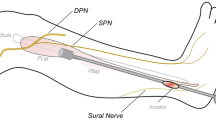Abstract
Purpose
The aim of this study was to elucidate the anatomical location of tibial nerve (TN) and common peroneal nerve (CPN) in the popliteal crease for specific nerve block.
Methods
Fifty fresh specimens from 27 adult Korean cadavers (16 males and 11 females, age 35–87 years) were investigated. Five of the 27 cadavers were used to determine the depths of nerves in cross-section.
Results
Tibial nerve was located 50 % from the most lateral point of the popliteal crease and 1.4-cm deep to the surface. In 20 % of the 50 specimens, the medial sural cutaneous nerve branched out below or at the popliteal crease, whereas the CPN was located at 26 % from the most lateral point of the popliteal crease and 0.7-cm deep from the surface. Furthermore, in 6 % of specimens the lateral sural cutaneous nerve branched out below or at the popliteal crease.
Conclusion
The results concerning the location of the TN and CPN at the popliteal crease offer a good guide to optimal nerve block.



Similar content being viewed by others
References
Bruyn GAW, Schmidt WA (2009) How to perform ultrasound-guided injections. Best Pract Res Clin Rheumatol 23:269–279
Buys MJ, Arndt CD, Vagh F, Hoard A, Gerstein N (2010) Ultrasound-guided sciatic nerve block in the popliteal fossa using a lateral approach: onset time comparing separate tibial and common peroneal nerve injections versus injecting proximal to the bifurcation. Anesth Analg 110:635–637
Driban JB, Swanik CB, Barbe MF (2007) Anatomical evaluation of the tibial nerve within the popliteal fossa. Clin Anat 20:694–698
Hadzic A, Vloka JD, Singson R, Santos AC, Thys DM (2002) A comparison of intertendinous and classical approaches to popliteal nerve block using magnetic resonance imaging simulation. Anesth Analg 94:1321–1324
Ikiz AA, Ucerler H, Bilge O (2005) The anatomic features of the sural nerve with an emphasis on its clinical importance. Foot Ankle Int 26:560–567
Lee JH, Lee BN, An X, Chung RK, Han SH (2011) Location of the motor entry point and intramuscular motor point of the tibialis posterior muscle: for effective motor point block. Clin Anat 24:91–96
Lee JH, Lee BN, An X, Chung RH, Kwon SO, Han SH (2011) Anatomic localization of motor entry point of superficial peroneal nerve to peroneus longus and brevis muscles. Clin Anat 24:232–236
Lepage D, Parratte B, Tatu L, Vuiller F, Monnier G (2005) Extra-and intramuscular nerve supply of the muscles of the anterior antebrachial compartment: applications for selective neurotomy and for botulinum toxin injection. Surg Radiol Anat 27:420–430
McCartney CJL, Brauner I, Chan VWS (2004) Ultrasound guidance for a lateral approach to the sciatic nerve in the popliteal fossa. Anesthesia 59:1023–1025
Mestdagh H, Drizenko A, Maynou C, Demondion X, Monier R (2001) Origin and make up of the human sural nerve. Surg Radiol Anat 23:307–312
Muniz MT, Alvarez J, Cortes J, Rodriguez J, Atanassoff PG (2003) Lateral approach to the sciatic nerve block in the popliteal fossa: correlation between evoked motor response and sensory block. Reg Anesth Pain Med 28:450–455
Nader A, Kendall MC, Candido KD, Benzon H, McCarthy RJ (2009) A randomized comparison of a modified intertendinous and classic posterior approach to popliteal sciatic nerve block. Anesth Analg 108:359–363
Paqueron X, Bouaziz H, Macalou D, Labaille T, Merle M, Laxenaire MC, Benhamou D (1999) The lateral approach to the sciatic nerve at the popliteal fossa: one or two injections? Anesth Analg 89:1221–1225
Parratte B, Tatu L, Vuillier F, Diop M, Monnier G (2002) Intramuscular distribution of nerves in the human triceps surae muscle: anatomical bases for treatment of spastic drop foot with botulinum toxin. Surg Radiol Anat 24:91–96
Robards C, Hadzic A, Somasundaram L, Iwata T, Xu D, Sala-Blanch X (2009) Intraneural injection with low-current stimulation during popliteal sciatic nerve block. Anesth Analg 109:673–677
Saleh HAM, El-fark MMO, Abdel-Hamid GA (2009) Anatomical variation of sciatic nerve division in the popliteal fossa and its implication in popliteal nerve blockade. Folia Morphol 68:256–259
Sinha A, Chan VWS (2004) Ultrasound imaging for popliteal sciatic nerve block. Reg Anesth Pain Med 29:130–134
Vloka JD, Hadzic A, April E, Thys DM (2001) The division of the sciatic nerve in the popliteal fossa: anatomical implications for popliteal nerve blockade. Anesth Analg 92:215–217
Acknowledgments
We thank Byung-Ouk Hong and Sang-Hyun Kim, Department of Anatomy Catholic Institute for Applied Anatomy, College of Medicine, The Catholic University of Korea, for help in gathering the data. This research was supported by basic science research program through the national research foundation of Korea (NRF) funded by the Ministry of Education, Science and Technology (NO. 2012R1A1A2007099).
Conflict of interest
The authors declare that they have no conflict of interest.
Author information
Authors and Affiliations
Corresponding author
Rights and permissions
About this article
Cite this article
Lee, JH., Lee, BN., Lee, M.Y. et al. The significance of tibial and common peroneal nerves in nerve blocks. Surg Radiol Anat 35, 211–215 (2013). https://doi.org/10.1007/s00276-012-1025-9
Received:
Accepted:
Published:
Issue Date:
DOI: https://doi.org/10.1007/s00276-012-1025-9




